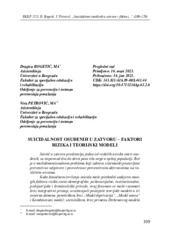Prikaz osnovnih podataka o dokumentu
Suicidalnost osuđenih u zatvoru – faktori rizika i teorijski modeli
Suicide of prison convicts – risk factors and theoretical models
| dc.creator | Bogetić, Dragica | |
| dc.creator | Petrović, Vera | |
| dc.date.accessioned | 2024-01-29T10:13:47Z | |
| dc.date.available | 2024-01-29T10:13:47Z | |
| dc.date.issued | 2023 | |
| dc.identifier.issn | 1820-2969 | |
| dc.identifier.uri | http://rfasper.fasper.bg.ac.rs/handle/123456789/5405 | |
| dc.description.abstract | Suicid u zatvoru predstavlja jedan od vodećih uzroka smrti osu đenih, sa stopom od dva do devet puta viša nego u opštoj populaciji. Reč je o multidimenzionalnom problemu koji zahteva sistematski postavljene preventivne odgovore i posvećenost preventivnim aktivnostima na ra zličitim nivoima. Kako konačnom izvršenju suicida može prethoditi sadejstvo mno gih faktora rizika socio-demografske, psihosocijalne, institucionalne, psihijatrijske i kriminološke prirode, ovaj fenomen se može razumeti kroz integrativni pristup, uvažavajući postojeće teorijske modele u tri osnovna domena: penološkom, kroz „Model deprivacija“, „Model unosa“ i Kombinovani model; sociološkom, kroz primenu Dirkemovog modela suicidalnosti na zatvorski kontekst; i psihološkom, kroz Interpersonalnu teoriju, Teoriju stresa i Teoriju reaktivne agresivnosti. Cilj rada jeste pregled razmera problema suicidalnosti osuđenih kroz povezivanje faktora rizika različitim teorijskim modelima koji objašnjavaju etiologiju suicida u zatvoru. U radu se koriste analiza i sinteza teorijskih i empirijskih nalaza kroz proučavanje relevantne literature u različitim naučnim izvorima podataka | sr |
| dc.description.abstract | Suicide in prison represents one of the leading causes of death among inmates, with a rate two to nine times higher than in the general population. This is a multidimensional problem that requires systematically established preventive responses and dedication to preventive activities at different levels. Since many risk factors of socio-demographic, psychosocial, in stitutional, psychiatric, and criminological nature can precede the act of committing suicide, this phenomenon can be understood through an integrative approach through, existing theoretical models covering three domains: the penological domain, through the “Deprivation Model”, “Importation Model”, and Combined Model; the sociological domain, through the application of Durkheim’s model of suicidality to the prison context; and the psychological domain, through Interpersonal Theory, Theory of Stress, and Theory of Reactive Aggressiveness. The aim of this paper is to review the scope of the problem of suicide among inmates by linking risk factors to different theoretical models that explain the etiology of suicide in prison. The paper uses analysis and synthesis of theoretical and empirical findings through the study of relevant literature from different scientific data sources | sr |
| dc.language.iso | sr | sr |
| dc.publisher | Beograd: Srpsko udruženje za krivičnopravnu teoriju i praksu i Institut za kriminološka i sociološka istraživanja u Beogradu | sr |
| dc.rights | openAccess | sr |
| dc.rights.uri | https://creativecommons.org/licenses/by/4.0/ | |
| dc.source | Revija za kriminologiju i krivično pravo | sr |
| dc.subject | suicidalnost osuđenih | sr |
| dc.subject | faktori rizika | sr |
| dc.subject | teorijski modeli | sr |
| dc.subject | fenomenološke razmere problema | sr |
| dc.subject | suicide of convicts | sr |
| dc.subject | risk factors | sr |
| dc.subject | theoretical models | sr |
| dc.subject | phenomenological dimensions of the problem | sr |
| dc.title | Suicidalnost osuđenih u zatvoru – faktori rizika i teorijski modeli | sr |
| dc.title | Suicide of prison convicts – risk factors and theoretical models | sr |
| dc.type | article | sr |
| dc.rights.license | BY | sr |
| dc.citation.epage | 129 | |
| dc.citation.issue | 2 | |
| dc.citation.spage | 109 | |
| dc.citation.volume | 61 | |
| dc.identifier.doi | 10.47152/rkkp.61.2.6 | |
| dc.identifier.fulltext | http://rfasper.fasper.bg.ac.rs/bitstream/id/11098/bitstream_11098.pdf | |
| dc.type.version | publishedVersion | sr |


